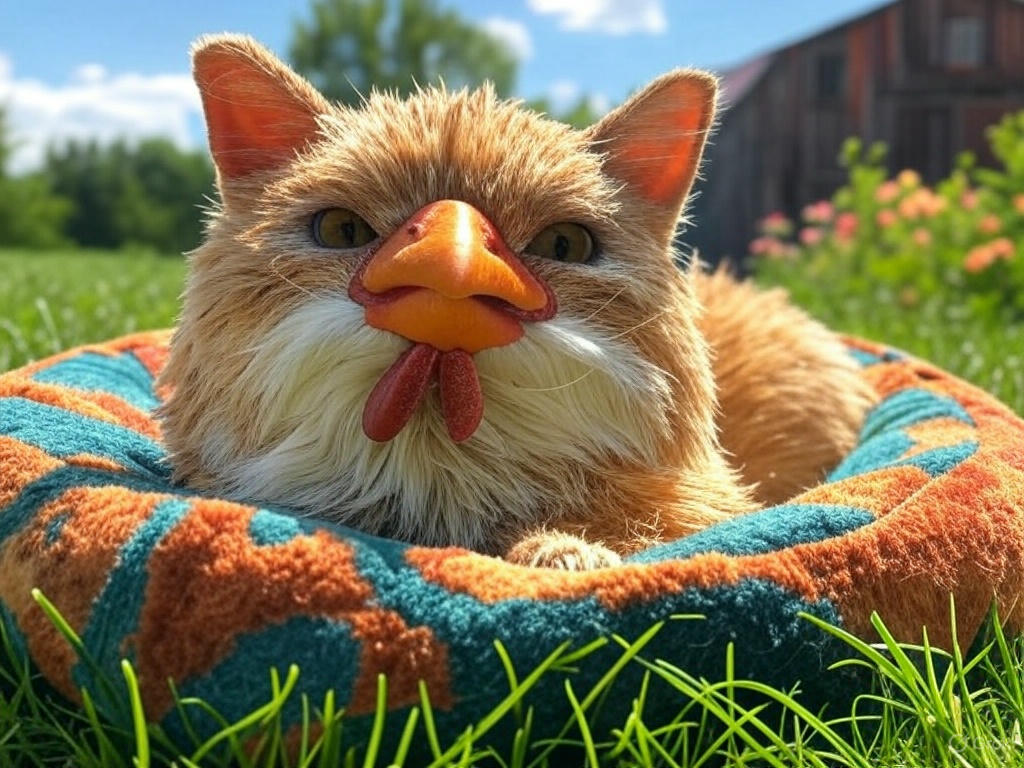Can Chickens and Cats Crossbreed? The Truth Behind the Viral Myth
Imagine a fluffy tabby cat with feathers instead of fur, clucking in your backyard. Sounds like something out of a fantasy novel, right? Recently, social media has been buzzing with claims about “chicken and cat crossbreeding,” sparking curiosity and confusion. But is there any scientific truth to this idea? Let’s dive into the biology, myths, and ethical implications of this bizarre concept.
Understanding Crossbreeding: What’s Possible in Nature?
Crossbreeding, or hybridization, occurs when two animals from closely related species mate and produce offspring. Famous examples include mules (horse + donkey) and ligers (lion + tiger). However, these hybrids share a critical factor: they belong to the same genus or family. Chickens (birds) and cats (mammals) are separated by over 300 million years of evolution, making crossbreeding biologically impossible.
The Genetic Barriers Between Birds and Mammals
Dr. Emily Carter, a geneticist at Stanford University, explains: “Mammals and birds have vastly different DNA structures, reproductive systems, and chromosome counts. Cats have 38 chromosomes, while chickens have 78. Even with advanced genetic engineering, merging these genomes would be like mixing oil and water.”
Why the Myth Persists: Hoaxes and Misinformation
The idea of a “chatken” or “chicken-cat” hybrid isn’t new. In 2019, a manipulated video of a featherless cat clucking went viral, amassing 10 million views. Similarly, April Fool’s Day pranks by pet blogs have fueled the myth. These hoaxes prey on our fascination with the strange and unknown.
Real-Life Examples of Animal Hybrids
While chicken-cat hybrids are fiction, real animal hybrids highlight nature’s creativity:
- Zebroids (zebra + horse)
- Wholphins (false killer whale + dolphin)
- Grolar Bears (grizzly + polar bear)
These hybrids thrive only under specific conditions, emphasizing how rare and complex cross-species breeding is.
The Role of Genetic Engineering: Could Science Create a Chicken-Cat Hybrid?
With CRISPR technology making headlines, could scientists “create” a chicken-cat hybrid? The answer is still no. While CRISPR allows gene editing within species (e.g., glow-in-the-dark fish), merging bird and mammal DNA remains science fiction.
Ethical Concerns: Playing Nature’s Role
Dr. Lisa Nguyen, a bioethicist, warns: “Attempting to hybridize such distant species raises serious ethical questions. Animals could suffer from health issues, identity confusion, or shortened lifespans.” Regulations like the Animal Welfare Act strictly limit such experiments to protect animal well-being.
Lessons from the “GloFish” Controversy
The creation of genetically modified GloFish in 2003 sparked debates about ethics and environmental impact. While GloFish are harmless, they illustrate the risks of tampering with nature for novelty—a cautionary tale for aspiring chicken-cat hybrids.
Debunking Viral Claims: How to Spot Fake Animal Hybrids
Next time you see a “chicken-cat” video, ask:
Q. Is the source credible?
A. Check websites like National Geographic or ScienceDaily for verification.
Q. Are there scientific citations?
A. Legitimate hybrids are documented in peer-reviewed journals.
Q. Does it defy basic biology?
A. Mammals + birds = red flag.
Case Study: The “Jackalope” Legend
The jackalope (rabbit + antelope) myth began in the 1930s as a taxidermy hoax. Like chicken-cat hybrids, it combines unrelated species but endures as cultural folklore.
Why We’re Fascinated by Hybrids: Psychology and Culture
Hybrid creatures tap into humanity’s love for the mysterious. From Greek myths (centaurs) to Pokémon (Mewtwo), blending species symbolizes innovation and fear of the unknown.
Modern Media’s Role in Fueling Myths
Movies like Splice (2009) and Island of Dr. Moreau sensationalize hybridization, blurring the line between science and fiction. Social media algorithms then amplify these fantasies, making myths feel plausible.
The Future of Crossbreeding: Science Fiction vs. Reality
While chicken-cat hybrids won’t grace our farms, science continues to explore ethical crossbreeding for conservation. For example, hybridizing endangered species with close relatives could boost genetic diversity.
Expert Predictions: Where Biology is Headed
Dr. Raj Patel, a zoologist, shares: “We’re more likely to revive extinct species like the woolly mammoth using CRISPR than to create chicken-cats. The focus is on preservation, not novelty.”
Conclusion: Embracing Reality While Celebrating Imagination
The chicken-cat crossbreeding myth reminds us of nature’s boundaries and humanity’s endless curiosity. While science fiction inspires innovation, respecting biological limits ensures ethical progress. Next time you see a “chatken,” smile—and share the real science behind the story.
FAQ
Q: Has a chicken and cat hybrid ever existed?
A: No. The genetic differences between birds and mammals make it impossible.
Q: What’s the closest real animal hybrid?
A: The mule (horse + donkey) is one of the most well-documented hybrids.
Q: Can genetic engineering create new hybrids?
A: Only within closely related species. Cross-class hybrids remain unfeasible.
Q: Why do people believe in animal hybrids like chicken-cats?
A: Cultural myths, viral hoaxes, and a love for the extraordinary drive these beliefs.
![]()
